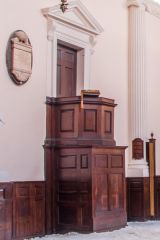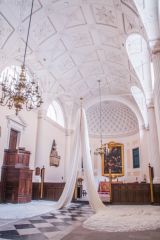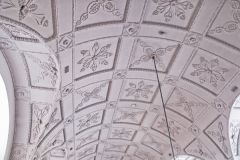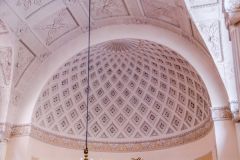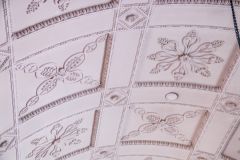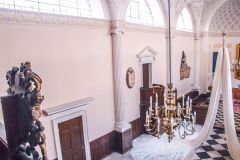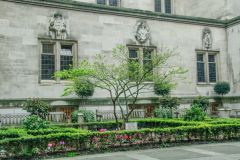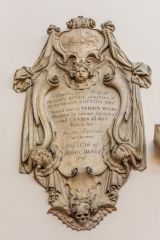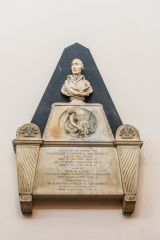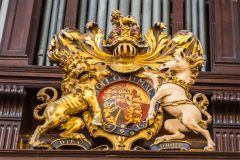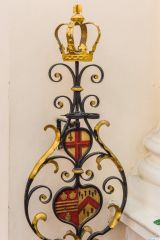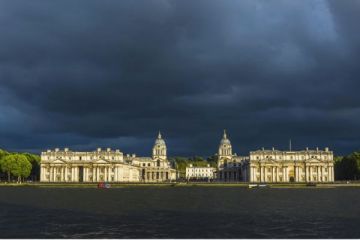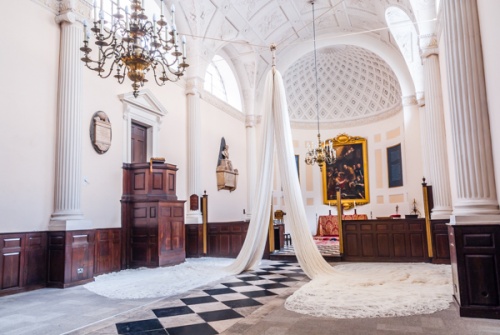
All Hallows London Wall (sometimes known for good reason as All Hallows on the Wall) was built in 1765 by George Dance the Younger (1741-1825), whose father George Dance the elder designed Mansion House, London.
The younger Dance was only 24 when he designed this delightful little church, tucked in beside the old Roman Wall of the City of London. In the churchyard are traces of the Roman wall, indicating the great antiquity of the site. The wall runs directly under the north wall of the church nave, so the church is, quite literally, 'on the wall'.

History
The original All Hallows London Wall was built around 1120. The medieval church was one of the few London churches to survive the Great Fire of 1666. A century on from the Great Fire the medieval church was in a poor state of repair. Rather than try to restore the medieval building, Dance chose to tear it down and build a completely new church in classical style.
Dance was heavily influenced by Italian classical design in his work and went on to become a founding member of the Royal Academy, and Clerk of the City Works for London, succeeding his father in that post. He later designed the infamous Newgate Prison (now destroyed).
The church itself is understated, almost plain, on the exterior, yet deliciously airy and light inside, with fluted Ionic columns supporting the vaulted ceiling. There is a gallery at the wet end with space for the 18th-century organ. Set on the gallery facade is a painted and gilded royal coat of arms. In the north-west corner of the nave is a neo-classical 17th-century font made of white marble.
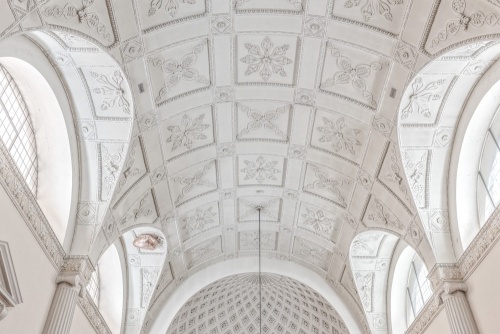
A Pulpit 'on the Wall'
The pulpit is tucked into the north wall, almost as an afterthought. One of the volunteer wardens told us that Dance may have neglected to include a pulpit in his original design and when this error became apparent he had to cram in a pulpit wherever he could. As a result, the pulpit is set directly against the wall.
In order for the vicar to ascend to the pulpit to preach, he had to go through a door in the north wall and take an external passage that linked to a stair. The stair would bring him to another door going back through the north wall to emerge in the pulpit.
Since the north wall was directly on the Roman city wall of London, the vicar had to literally leave London and then return in order to preach to the congregation. This led to many jests about All Hallows being the only London church where the vicar had to leave the city in order to preach a sermon.
The church suffered minor damage by bombs during the Blitz, but the restoration was sympathetically performed and does not detract from the overall effect of Dance's work. It was damaged again by IRA bombs in 1993 and again restored.
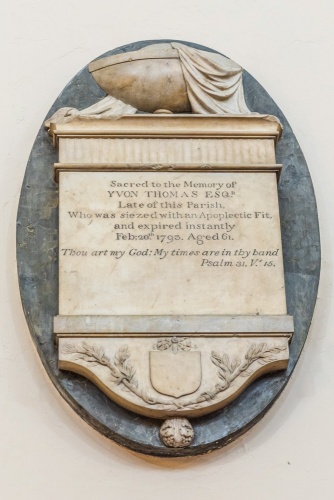
Apoplectic Memorial
Directly beside the pulpit is a wall tablet in memory of Yvon Thomas Esq. The epitaph tells us that Thomas 'was siezed [sic] with an apoplectic fit and expired instantly' on 20 February 1793. Our friendly volunteer guide told us the rest of the story. Apparently, Thomas' apoplectic fit was brought on when he received word from his accountant that he had been assessed a large tax bill. The news of the bill brought on the fit that killed him.
Another memorial plaque commemorates Edmond Hammond (d. 1642). Hammond left money in his will to support 150 'pious uses'. Another 17th-century tablet commemorates Joan Bence (d. 1684). Her epitaph tells a tragic story; Joan and her first husband John Wood had 'several' children, all of whom died before her.
Perhaps the most ornate memorial in All Hallows is that of Joseph Patience, an architect who died in 1797, to be followed a year later by his wife Mary. The memorial also commemorates Joseph Patience II (d. 1822), who, like his father, became an architect.

The Sword Rest
Like all London churches, All Hallows has a Lord Mayor's sword rest. Until 1883 the Lord Mayor would worship at each London church in turn, and each church provided an elaborate sword rest where the Mayor's official swordbearer would put his ceremonial sword of state.
Most sword rests are surmounted by a royal crown and the City of London's coat of arms. Many others have the Lord Mayor's personal coat of arms and the arms of any livery companies of which he was a member. The All Hallows sword rest has the royal crown but no royal or city coat of arms.
Visiting
The first time I visited All Hallows an art exhibition was taking place, and the interior was filled with flowing lace cloth, giving the Georgian interior an almost ethereal look. The interior is not awe-inspiring, but beautifully understated, with wonderful classical columns projecting from the walls, rising up to an ornately carved barrel-vaulted ceiling.
At the east end, the rounded apse echoes the same curving lines as the ceiling. This is a lovely period-piece, with excellent woodwork and beautifully crafted 18th-century details.
About All Hallows London Wall
Address: 83 London Wall,
London,
Greater London,
England, EC2M 5ND
Attraction Type: Historic Church
Website: All Hallows London Wall
Location
map
OS: TQ330814
Photo Credit: David Ross and Britain Express
Nearest station: ![]() Liverpool Street - 0.1 miles (straight line) - Zone: 1
Liverpool Street - 0.1 miles (straight line) - Zone: 1
HERITAGE
 We've 'tagged' this attraction information to help you find related historic attractions and learn more about major time periods mentioned.
We've 'tagged' this attraction information to help you find related historic attractions and learn more about major time periods mentioned.
Historic Time Periods:
Find other attractions tagged with:
18th century (Time Period) - Georgian (Time Period) - Restoration (Historical Reference) - Roman (Time Period) -
NEARBY HISTORIC ATTRACTIONS
Heritage Rated from 1- 5 (low to exceptional) on historic interest
St Andrew Undershaft - 0.2 miles (Historic Church) ![]()
London Guildhall - 0.2 miles (Historic Building) ![]()
Leadenhall Market - 0.3 miles (Historic Building) ![]()
London's Roman Amphitheatre - 0.3 miles (Roman Site) ![]()
Guildhall Art Gallery - 0.3 miles (Museum) ![]()
St Botolph without Aldgate - 0.4 miles (Historic Church) ![]()
St Stephen Walbrook - 0.4 miles (Historic Church) ![]()
St Lawrence Jewry - 0.4 miles (Historic Church) ![]()
Nearest Holiday Cottages to All Hallows London Wall:
Leaves Green, Greater London
Sleeps: 6
Stay from: £871 - 3614
Culverstone Green, Kent
Sleeps: 2
Stay from: £356 - 1253
More self catering near All Hallows London Wall
